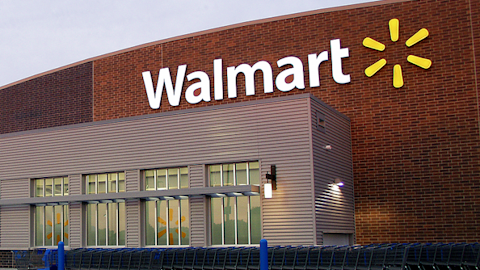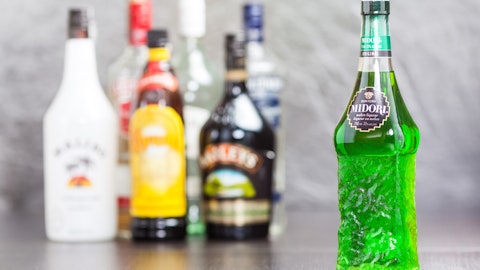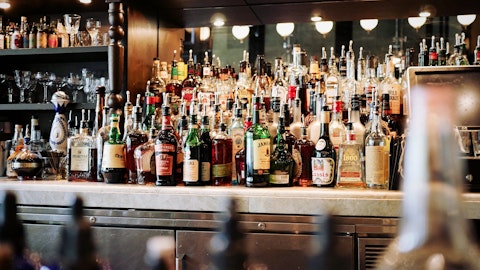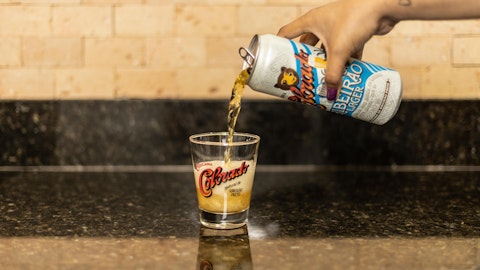Molson Coors Beverage Company (NYSE:TAP) Q4 2022 Earnings Call Transcript February 21, 2023
Operator: Good day, and welcome to the Molson Coors Beverage Company Fourth Quarter and Fiscal Year 2022 Earnings Conference Call. You can find related slides on the Investor Relations page of Molson Coors website. Our speakers today are Gavin Hattersley, President and Chief Executive Officer; and Tracey Joubert, Chief Financial Officer. With that, I’ll hand over to Greg Tierney, Vice President of FP&A and Investor Relations. Please go ahead.
Greg Tierney: Thank you, operator, and hello, everyone. Following prepared remarks today from Gavin and Tracey, we will take your questions. In an effort to address as many questions as possible, we ask that you limit yourself to one question. If you have technical questions on the quarter, please pick them up with our IR team in the days and the weeks that follow. Today’s discussion includes forward-looking statements. Actual results or trends could differ materially from our forecast. For more information, please refer to the risk factors discussed in our most recent filings with the SEC. We assume no obligation to update forward-looking statements. GAAP reconciliations for any non-U.S. GAAP measures are included in our news release.
Unless otherwise indicated, all financial results the Company discusses are versus the comparable prior year period in U.S. dollars and in constant currency when discussing percentage changes from the prior year period. Also, in order to better align with GAAP reported metrics in our filings and simplify reporting, references to net sales per hectoliter will now be on a financial volume basis, instead of on a brand volume basis. Further, in our remarks today, we will reference underlying pre-tax income, which equates to underlying income before income taxes on the condensed, consolidated statements of operations. With that, over to you, Gavin.
Gavin Hattersley: Thanks, Greg and thank you all for joining us this morning. I’m very pleased to tell you that three years after launching our Revitalization Plan to turnaround this business, and three years after pledging to deliver top and bottom-line growth, we have done exactly that. We grew the top-line by 7%. We grew the bottom-line by almost 8%. We brought our leverage ratio under 3 times. We stuck to our strategy and our plans and we delivered despite the fact that many people didn’t think we could. To be sure, there’s been a lot of ups and downs in the past three years. But through it all, achieving consistent top and bottom-line growth has been our North Star. And we are well on the road to doing just that. And many questioned our ability to execute this plan.
So, I want to take a couple of minutes to break down how we arrived at this moment. First, we streamlined our business in 2019 and early 2020 to drive significant savings. Second, we built on the strength of our core brands for the past three plus years. The results, Coors Light and Miller Lite revenues are both well above 2019 levels in the United States. Collectively, Coors Light and Miller Lite grew both U.S. volume and dollar share in the fourth quarter. They even combined to outperform the combination of Michelob Ultra and Bud Light in U.S. volume share performance for the fourth quarter. And in the fourth quarter Coors Light and Miller Lite’s combined volume share exceeded Bud Light in tracked channels. And in Canada, we’re also seeing strength as Molson Canadian grew revenue and industry share in 2022.
In the UK, Carling continues to be the number one brand in the market. These trends didn’t just suddenly appear. They’re the result of consistent brand messaging, and more effective brand investment. Thirdly, we have aggressively premiumized our portfolio. Today, over 28% of our global net sales revenue now comes from our above premium portfolio, up from 23% in 2019. Our U.S. above premium portfolio gained the second most dollar share of all major U.S. brewers in 2022. And while our seltzer portfolio, of course, was a contributor, our progress is driven by more than just seltzer. Peroni’s 2022 revenues were up double digits in the U.S. compared to 2019 levels, even though the brand skews heavily to the on-premise. Blue Moon’s 2022 U.S. revenues were also higher compared to 2019, aided by the successful launch of Blue Moon LightSky.
Simply Spiked, which we introduced last summer, quickly became the fastest growing new innovation in the U.S. FAB category. In Canada, our craft division grew brand volume double digits in 2022. And we have the only hard seltzer portfolio gaining industry share in that market. But the standout star of our global portfolio continues to be Madrà Excepcional in the UK. I really want you to understand the tremendous growth of this brand and its size today. In less than two years it has become one of our top five above premium brands globally. Fourthly, we expanded beyond beer, where we have laid solid foundations in energy drinks and full strength spirits, which are totally new spaces for us. ZOA continued to grow very strongly. Brand volumes were up triple digits in both the fourth quarter and the full year, with trend acceleration in the quarter.
Our first full strength spirit Five Trail is enjoying expanded distribution to more states and select international markets. And building on the continued success of Topo Chico Hard Seltzer, we are expanding our partnership with the Coca-Cola Company to release Topo Chico Spirited this spring to compete in the fast-growing ready-to-drink cocktail space. And finally, we have invested in our future. We’ve added brewery capabilities throughout our network, completing the build of two new state-of-the-art modern breweries in Canada, adding hard seltzer and slim can production capabilities and building a new variety packing facility in Texas. And we’re in the midst of a large-scale modernization of our Golden Colorado brewery, which supports improved efficiencies and helps us deliver our sustainability goals.
This work shows our 2022 results aren’t an aberration or a moment in time. Our top and bottom line growth is the product of three years of hard work under our Revitalization Plan. We are proving this company can grow profitably, and we intend to continue demonstrating that in the years ahead. Of course, we expect various ups and downs over the next few years. And just like many other consumer goods companies that have reported this year, we see reasons for caution about the consumer landscape in the immediate term, not just for beer, but for consumer goods more broadly. Beer has traditionally been very resilient during tough economic times. Yet it is true that U.S. industry-wide beer volumes fell at a much higher rate in the fourth quarter than they had earlier in the year.
Much of this has been attributed to most of the beer industry taking a second price increase in the calendar year. And yet beer as a category has maintained its share of basket at retail. So consumers are not reducing beer purchasing in favor of other staples. Additionally, Beer actually gained share of total alcohol beverage in the quarter. So, consumers are not switching to other alcohol beverages. And in fact, notwithstanding the comments made by a large upstream supplier, we see the pricing taken in 2022 still sticking across our markets earlier this year. So, if pricing were the driving reason behind the softer industry trends, we would have expected it to adversely impact the beer industry relative to other consumer staples or other alcohol beverage categories, and we haven’t seen that.
But what we have seen is a subset of value-conscious U.S. consumers who are actively trading down into smaller pack sizes. We have also seen the economy segment continue to strengthen. The uncertainty these broad consumer trends that all companies are facing in 2023 are a driving factor in our more modest guidance for this upcoming year, despite our relatively more optimistic outlook for the medium term where we anticipate delivering higher top and bottom line growth rates than we expect in 2023. At the same time, we expect to see margin improvement over the medium term. This is supported by our goal for our above-premium portfolio to reach approximately one-third of our global net sales revenue over the medium term. So, even in this challenging and uncertain economic climate, we expect to deliver against the North Star of our Revitalization Plan by achieving top and bottom line growth at Molson Coors with margin improvement on a consistent long-term basis.
Our portfolio is strategically built for strength across the range of pricing tiers within the beer industry. That gives us greater stability than some of our competitors in any economic climate. But some of that is a reflection of the simple fact that Molson Coors’ revenue and profit trajectories are stronger than they have been in years, and our business is healthier today. We are a much leaner business than we were in 2019. We have powerful core brands across our global markets that are seeing renewed strength. We are premiumizing our portfolio with strong innovations around the world. We are diversifying our offerings to consumers. We’re building the capabilities today that will power this business tomorrow. We’re investing in our people.
And for the first time in a while, we are delivering real results. Thanks to the work of thousands of people around the world. That’s the story of Molson Coors today, and that’s what you should all expect from us consistently over the long term as well. Now to give you more detail on the financials and outlook, I’ll hand it over to our Chief Financial Officer, Tracey Joubert. Tracy?
Tracey Joubert: Thank you, Gavin, and hello, everyone. In 2022, on a constant currency basis, we grew net sales revenue 7%, exceeding our guidance and underlying pretax income 7.6%, delivering our guidance. This performance resulted in record underlying pretax income levels for a fourth quarter, which many questioned we could achieve. But we delivered with underlying pretax income up 51.1%. We did this despite the challenging global macroeconomic environment and a softer beer industry all while continuing to invest in our business and enhancing our financial flexibility and returning cash to shareholders. Now, before I take you through our results and outlook, as a reminder, we discussed our business performance on a constant currency basis.
However, currency impact from the strong U.S. dollar did have a meaningful impact on our top line and resulted in a net sales revenue headwind to reported results of $89 million in the fourth quarter and $298 million for the year. Now let’s talk about some of the drivers of the fourth quarter performance. Our ability to take strong global net pricing and deliver positive sales mix across both business units led to 11.4% net sales per hectoliter growth. Financial volumes declined 6.9%. The biggest drivers were lower brand volumes in the Americas given the industry softness as well as cycling a significant prior year distributor inventory build in the U.S. Conversely, EMEA and APAC financial volumes increased, resulting from a fairly resilient consumer in the UK and cycling Omicron-related restrictions in the prior year period.

Syda Productions/Shutterstock.com
Turning to costs. As expected, inflationary pressures continued to be a headwind in the quarter, driving underlying COGS per hectoliter up 11.5%. As you can see from the slide, we bucket costs into three areas: cost inflation/other, which includes cost inflation, depreciation, cost savings and other items; mix; and deleverage. The cost inflation bucket drove approximately two-thirds of the increase and was mostly due to higher materials, energy and transportation costs. Cost savings provided some offset, and we are pleased to report that we completed another successful cost savings program, delivering over the $600 million in targeted savings from 2020 to 2022. Now, we also have an extensive hedging program, and it has helped to mitigate some of these cost pressures.
But remember, certain costs like freight and raw material conversion costs and third-party manufacturing contracts cannot be hedged and are generally linked to inflationary indexes like PPI. And these costs can be material contributors to COGS. Other COGS per hectoliter drivers were mix and volume deleverage. Mix was about 20% of the increase, and it was largely due to premiumization. And while premiumization is a negative for COGS, it is a positive for gross margin per hectoliter. Turning to marketing. As planned, it was down for the quarter. That said, we continued to put strong commercial pressure behind our core brands and innovation. And the year-over-year comparison simply reflects the significantly higher spend in the prior year period when investments exceeded fourth quarter 2019 level.
Now before I move on to our business unit performance, I wanted to call out two other items on our P&L in the quarter. We had a $15 million discrete tax benefit, which resulted in lower-than-anticipated underlying effective tax rate for the quarter and for the full year. We do not expect this to repeat. Also, we recorded an $845 million noncash partial impairment charge in Americas due to macroeconomic factors like rising interest rates and increased Cost inflation that reduced our future expected cash flows in the near to medium term. This charge was a result of our annual goodwill impairment review and is excluded from our underlying results. Now let’s look at our quarterly results by business units. In the Americas, net sales revenue was up 0.4%, while underlying pretax income grew 29.8%.
Americas’ net sales per hectoliter increased 12.1%, benefiting from strong net pricing growth and favorable U.S. brand mix. Financial volumes declined 10.5%. This was a result of lower brand volumes, which were down 6.6%. They were also down due to cycling significant distributor inventory builds in the U.S. in the prior year period, which we discussed last quarter. Taking a deeper look at brand volumes by region, the U.S. accounts 6.8%. Now, we had some timing items that impacted this performance. First, there was one less trading day in the quarter. So, on a trading day adjusted basis, U.S. brand volumes were down 5.4%. Additionally, as with any price increase, we experienced volume load in from the four price increase that shifted volume out of the fourth quarter.
Looking at U.S. brand volume by price segment, our economy and premium portfolios were down high single digits on a non-trading day adjusted basis, despite industry share trend improvement in economy and industry share gains in premium. But our best premium brands grew in the quarter, up low single digits. In Canada, industry softness resulted in brand volume declines of 5%, and in Latin America, they were down 6.9%. On the cost side, Americas underlying COGS per hectoliter increased 11.4%, while MG&A decreased 12.6%. The drivers were similar to those discussed for the consolidated results. Turning to EMEA and APAC. Net sales revenue increased 20.3% and underlying pretax income increased 515% or over $23 million. Positive net pricing, favorable sales mix on record premiumization fueled by the strength of brands like Madrà and positive channel mix drove net sales per hectoliter growth of 14.9%.
Financial volumes grew 4.7% on the strength of our above premium portfolio, including the benefits of cycling Omicron-related restrictions in the prior year period. Brand volumes declined 1%. While brand volumes grew in the UK and Central and Eastern Europe, they were more than offset by declines in our license and export business in markets impacted by the Russian war in Ukraine. On the cost side, underlying COGS per hectoliter increased 16.5%, this is largely due to cost inflation, mainly higher materials, transportation and energy costs as well as mix from premiumization. Now, let’s look at the full year. Net sales per hectoliter were up 9.3% on strong global net pricing and positive sales mix across both business units. Financial volumes declined 2.1%, essentially in line with brand volumes, which were down 2%.
Financial volume declines were due to the Americas where brand volumes declined 3.3% on softer U.S. and Canada’s beer industry and also the Quebec labor strike that impacted the second and third quarters of 2022. Conversely, financial and brand volumes were up in the UK, given the resilience of the UK consumer in the quarter and cycling prior year on-premise restrictions. Turning to profitability. Underlying cost per hectoliter increased 11%. And when looking at our cost bucket, the biggest driver was cost inflation, which was over 60% of the increase and due to similar drivers as in the fourth quarter. And this was followed by mix, which contributed to nearly 30% of the increase. Notably, underlying COGS per hectare to increase varies significantly by business unit, with Americas up approximately 10%, and EMEA and APAC up to nearly 20%.
MG&A increased 3.7%. This was mainly due to higher people-related G&A costs. Marketing spend declined for the year, but we continued to invest strongly behind our core brands and key innovation. And in fact, marketing investments was up for the full year when excluding discontinued brands. We delivered underlying free cash flow of $853 million for the year. This was down $230 million, primarily due to unfavorable timing of working capital and higher cash capital expenditures, partially offset by lower cash taxes. Underlying free cash flow was below our guidance range, largely due to unfavorable movements in working capital compared to our initial expectations. We do not expect these working capital movements to impact us in 2023. Turning to capital allocation.
Our priorities remain to invest in our business to drive top line growth and efficiencies, reduce net debt and return cash to shareholders. Capital expenditures paid were $661 million for the year, up $139 million as we continue to expand our capabilities, as Gavin discussed. We continued to improve the health of our balance sheet by reducing net debt by $562 million during the year. We ended the year with net debt of $6 billion, which is essentially all at fixed rate. Our exposure to floating rate debt is limited to our commercial paper and revolving credit facility, which had a zero balance outstanding as of year-end. We achieved our net debt to underlying EBITDA ratio guidance of under 3 times, coming in at 2.9 times at year-end. This is a dramatic improvement from the 4.8 times in 2016 at the time of the MillerCoors acquisition.
We remain committed to maintaining anytime, improving our investment-grade rating and strive towards a longer-term leverage ratio target of approximately 2.5 times. And we continued our long history of returning cash to our shareholders with a quarterly cash dividend of $0.38 per share paid in the fourth quarter. And on February 20th, our Board declared a quarterly cash dividend of $0.41 per share, an increase of 8%. This is our second increase since we reinstated the dividend in 2021, and it aligns with our intention to sustainably increase the dividend. Now, let’s discuss our outlook and recall that we provide year-over-year growth rate in constant currency. Our 2023 guidance anticipates continued growth despite softness in the beer industry and the impact of continued global inflationary cost pressures.
We expect low-single-digit growth for both net sales revenue and underlying pretax income and underlying free cash flow of $1 billion, plus or minus 10%. Now, let me walk through some of the underlying assumptions. On the top line, we expect growth to be more rate than volume driven as we continue to benefit from the strong global net pricing that we took in 2022 as well as premiumization. As a reminder, in 2022 in the U.S., our largest market, we took an average 5% increase in the first quarter and another 5% beginning in September and into the fourth quarter. In terms of cost, we expect inflation to continue to be a headwind. But, with our ongoing cost savings efforts — pricing and continued premiumization, we expect to grow gross margin per hectoliter in both business units.
We also remain comfortable with our hedge commodities coverage in 2023. But again, there are certain costs, as I discussed, that cannot be hedged and can be material contributors to COGS. We also expect to continue to strongly support our core brands and key innovations and plan to increase marketing dollar investments in 2023 versus the prior year. As for our secondary guidance metrics, we expect capital expenditures incurred of $700 million, plus or minus 5%; underlying depreciation and amortization of $690 million, plus or minus 5%; net interest expense of $240 million, plus or minus 5%; and an underlying effective tax rate in the range of 21% to 23%. In closing, we are proud of our accomplishments in 2022, particularly amidst significant global inflationary pressures.
We remain focused on continuing to navigate the dynamic macroeconomic environment. And we are pleased to have a strong portfolio of brands that play across all price segments and the financial flexibility that enables us to continue to invest prudently in our business to support long-term growth. With that, we look forward to answering your questions. Operator?
See also Mario Gabelli Stock Picks: Top 15 and 10 Most Promising Chinese Stocks.
Q&A Session
Follow Molson Coors Beverage Co (NYSE:TAP)
Follow Molson Coors Beverage Co (NYSE:TAP)
Operator: Our first question comes from Bonnie Herzog of Goldman Sachs.
Unidentified Analyst: Hi there. This is Patty Kanada on for Bonnie. Thanks for the questions. I just had a couple of them on your EMEA-APAC performance. Your financial volumes across the broader region were much better than expected. Could you break out for us how much of a tailwind the World Cup was? And any other benefits that may be one-off like the cycling of the on-premise restrictions you pointed out in terms of contribution? And then, hoping to dig a little bit more on what you’re seeing at the consumer level in Central and Eastern Europe, specifically given the pressures on demand that we were talking about last year. Did you say that volumes actually recovered in this region? And could you just give us an update on the consumer demand trends you’re seeing there? Thank you.
Gavin Hattersley: Thanks very much, and good morning. As far as EMEA and APAC is concerned, yes, I mean, they drove top line growth in the quarter. And yes, we did benefit from cycling Omicron-related on-premise restrictions, which we had in 2021. We benefited from strong pricing and mix as well. And our above premium portfolio reached record levels on the strength of big success brand like MadrÃ. But, the World Cup was a contributor, but it wasn’t frankly, as much as we had expected, for a couple of reasons. One is it was out of cycle. So, it’s normally played in the summer. And secondly, there were significant rail strikes in the UK around that time. And so not only did that mute consumer demand due to the World Cup, but it also muted the expected demand that we were hoping for as the Christmas — holiday parties and spirit came through, which didn’t happen in 2021.
Both of those things were less than what we had expected. Notwithstanding that, obviously, the performance in EMEA-APAC was substantially better than 2021 and nearly where we had hoped. As far as EMEA-APAC is concerned, look, the inflationary impacts that we’re facing are more notable in those markets. Obviously, there are specific conditions affecting Europe from Russia’s war in Ukraine. And there are challenges in the UK economy. There’s no doubt about that. So Central Eastern Europe remains a challenged market. But in the UK to date, market demand has been resilient, including demand for our — for above premium brands.
Operator: Our next question comes from Peter Grom of UBS. Peter, your line is open. Please go ahead.
Unidentified Analyst: This is Bryan Adams on for Peter Grom. Congrats on an awesome quarter. So just thinking through the low single-digit top line growth that you guys outlined this morning, Tracey, you just talked through the rollover benefit from pricing in 2022 along with a broader effort to continue to shift towards above premium. I know you’re targeting a third of the portfolio now, and that should probably provide some positive mix. But just thinking through that low single digits for the year, how should we think about that broader breakdown between price mix and volume? Is it still going to be mostly a price-mix driven affair in €˜23? Thanks.
Gavin Hattersley: Yes. I mean, as Tracey said in her remarks, it’s going to be more rate than it’s going to be volume. Obviously, near term, consumer behavior and consumer impacts, as you can see in any consumer goods company is challenging. And so we’re a little cautious there from a volume perspective. So, more rate than volume for sure. And we’ve got the other thing going on in our top line our contract brewing, right? I mean, it’s well known that we’re exiting a large contract brewing arrangement, which is coming to an end. I think it’s the end of next year. And this year is a transition year. So it’s a decent chunk of that volume comes out. And that’s obviously carries a fair amount of NSR with it. Now, we are confident that it will take a lot of complexity out of our business and reduce our overall cost structure, and it’s just going to make us a whole lot more efficient. So, we’re in the transition year from that as well. So hopefully, that answers that, Bryan.
Operator: Our next question comes from Bill Kirk of ROTH MKM.
Bill Kirk: So my question is what is the right level of ad spend? Obviously, 4Q had the year-over-year ad declines. But you’re seeing some competitors increase their spending on their core brands. So, I guess the question is, do you need to adjust your marketing strategies from 2022 levels? How should we think about maybe the response to some of the extra marketing competitors are putting in the marketplace?
Gavin Hattersley: Thanks for the question, Bill. Look, I mean, we’re very pleased with the strength of our marketing and the effectiveness of that marketing. And we invested strongly behind our core brands and key innovations, and we plan to continue to do that. I think it was in Tracey’s prepared remarks, not mine, that if you exclude discontinued brands, our marketing investments were actually up for the year. Marketing spend on our iconic core brands, in aggregate was also up for the year in constant currency. So, we think our marketing is working. We have made some changes to our approach from a marketing investment point of view. We’ve completely changed our approach to media to make sure that our dollars work really hard for us.
We’ve now got more than 50% of our media spend in digital channels. And we’ve been leading the way in places like streaming videos. And we’re into podcasting and sports predictions and betting, as you saw from our latest Super Bowl program. We’ve also completely overhauled our approach to performance-based marketing to make sure that we get the absolute best return on ad spend and to maximize our effectiveness. So, I guess, Bill, that’s a long-winded way of saying, we’re making every single dollar work as hard for us as possible. As it relates to some of our competitors, I like where our brands are relative to our competitors. I like where they are from a health point of view, I like where they are from a share point of view. And I’m not — yes, I mean, if you increase something 5 times of a relatively low base, it’s still a relatively low number.
And as Tracey said, we’re going to continue to invest heavily behind our brands, and we are planning to increase our ad spend in 2023.
Operator: Our next question comes from Andrea Teixeira of JP Morgan.
Drew Levine: This is Drew Levine on for Andrea. Thank you for taking our question. I wanted to pick up on the discussion around the top line guidance for this year. Can you just clarify if you had additional pricing planned for 2023 given the consumer environment? And then, Gavin, obviously, kind of a tough end to year from a volume perspective and the industry. Can you just talk about what you’re seeing year-to-date and maybe how much conservatism do you think is baked into the guidance? Were you going kind of based off of the transecting 2022, or are you seeing something in the marketplace currently? I guess, that’s giving you some pause. Thank you.





